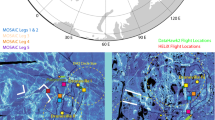Abstract
In 2011, dozens of satellites are collecting measurements on the atmosphere, continents, oceans, ice caps and interior. Government agencies such as the U. S. Geological Survey (USGS) operate many of them. In many cases, satellite data is sold to companies that analyze it, construct new data products and sell these. A good example is a weather company. It buys satellite data, uses it to make detailed weather forecasts, and then sells these forecasts to airlines. An airline, such as Delta, then uses the forecasts to determine whether it is safe to fly an aircraft or what areas will have extreme air turbulence. A flight might also be diverted to another airport because of extreme wind shear. Wind shear is able to tear a plane apart and, hence, this diversion may have save lives. Wind shear is described in Chap. 1.
Access this chapter
Tax calculation will be finalised at checkout
Purchases are for personal use only
Similar content being viewed by others
References
Farrell SL, Laxon SW, McAdoo DC et al (2009) Five years of arctic sea ice freeboard measurements from the ice, cloud and land elevation satellite. J Geophys Res 114:C04008. doi:10.1029/2008JC005074
Haigh JD, Winning AR, Toumi R et al (2010) An influence of solar spectral variations on radiative forcing of climate. Nature 467:696–699
James N, Mason J (2003) Light levels at the 2002 December 4 eclipse. J Br Astron Assoc 113:195
Rodell M, Velicogna I, Famiglietti JS (2009) Satellite-based estimates of groundwater depletion in India. Nature 460:999–1002
Rottman G, Harder J, Fontenla J et al (2005) The spectral irradiance monitor (SIM): early observations. Sol Phys 230(1/2):205–224
Tapley BD, Bettadpur S, Ries JC et al (2004) GRACE measurements of mass variability in the Earth system. Science 305:503–505
Willson RC, Mordvinov AV (2003) Secular total solar irradiance during solar cycles 21–23. Geophys Res Lett 30(5):1199. doi:10.1029/2002GL016038
Yang Y, Marshak A, Várnai T et al (2010) Uncertainties in ice-sheet altimetry form a spaceborne 1064-nm single channel lidar due to undetected thin clouds. IEEE Trans Geosci Remote Sens 48(1):250–259
Author information
Authors and Affiliations
Rights and permissions
Copyright information
© 2012 Springer Science+Business Media New York
About this chapter
Cite this chapter
Schmude, R. (2012). Earth Observing and Weather Satellites. In: Artificial Satellites and How to Observe Them. Astronomers' Observing Guides. Springer, New York, NY. https://doi.org/10.1007/978-1-4614-3915-8_3
Download citation
DOI: https://doi.org/10.1007/978-1-4614-3915-8_3
Published:
Publisher Name: Springer, New York, NY
Print ISBN: 978-1-4614-3914-1
Online ISBN: 978-1-4614-3915-8
eBook Packages: Physics and AstronomyPhysics and Astronomy (R0)




